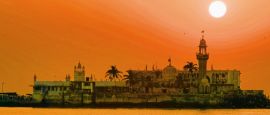Mumbai (Bombay) History
Mumbai owes its colourful present to its equally interesting past.
Originally a group of seven islands inhabited by Koli fishermen, the area was surrendered to Portugal in 1534, who called it ‘Bom Bahia’ meaning ‘the good bay’.
The English arrived in the early 17th century and the Portuguese handed them the city in 1661 as part of a dowry to King Charles II when he wed his Portuguese consort Catherine of Braganza.
The king didn’t want the trouble of ruling this far-off city (then called Bombay), so it was leased to the East India Company for 10 pounds of gold a year, and soon expanded.
In 1687, the Company made Bombay their Indian headquarters and within a century it had become the Gateway to India.
Control of Bombay passed back to the Crown in 1858. The city stayed in British hands until independence in 1947, and it was during this 90-year period that modern Bombay really took shape.
This included ambitious building projects and the reclamation of the seven islands to turn Bombay into one large island. Meanwhile, the cotton trade boomed, while the opening of the Suez Canal cemented Bombay’s port as a commercial hub.
Since independence, the city’s history has been pockmarked with violence. Communal strife resulted in 1960 in the state of Bombay being split into Maharashtra and Gujarat.
Communal rioting led to the deaths of 800 people in 1992 following the destruction of the Babri Masjid mosque, while in 1996, a railway bomb which killed more than 200 people was also the result of religious tensions.
In 2008, the city came under coordinated terrorist attack by Islamic-trained militants from Pakistan, who killed more than 160 people.
Today, Mumbai is an economic powerhouse and home to vast numbers of government employees along with a large pool of self-employed workers, who earn their living as hawkers, taxi drivers, mechanics and other blue-collar professions.
Did you know?
• India’s first train set off from Mumbai in 1853.
• Established in 1969, Sanjay Gandhi National Park is surrounded by Mumbai on three sides.
• Dharavi, Mumbai’s central slum, has about 20,000 micro factories.
Do you have any Feedback about this page?
© 2025 Columbus Travel Media Ltd. All rights reserved. No part of this site may be reproduced without our written permission, click here for information on Columbus Content Solutions.




 You know where
You know where